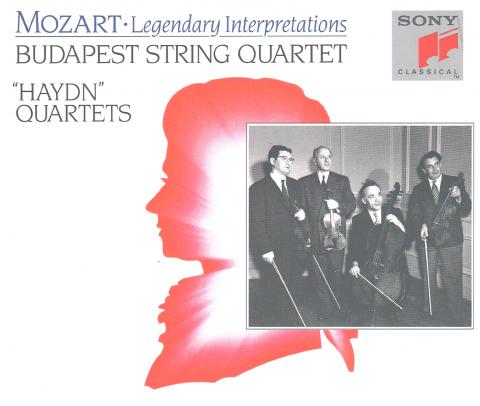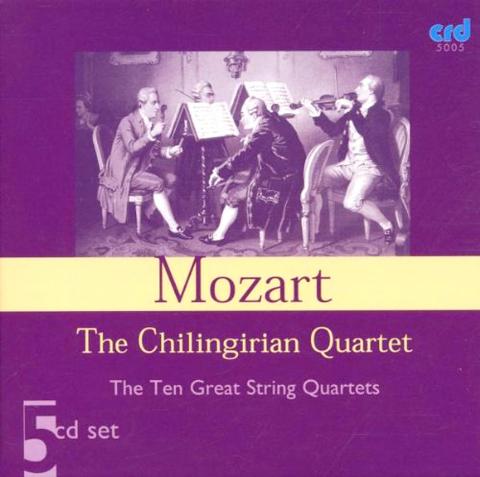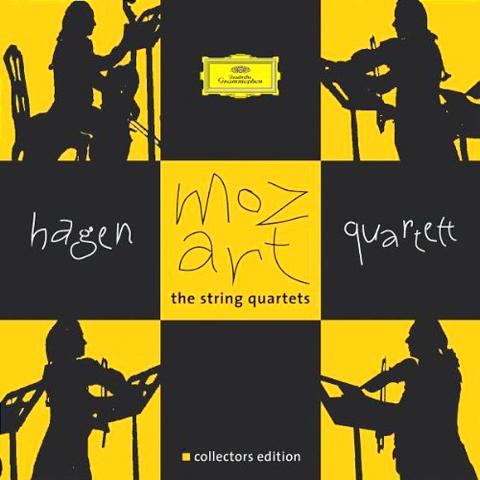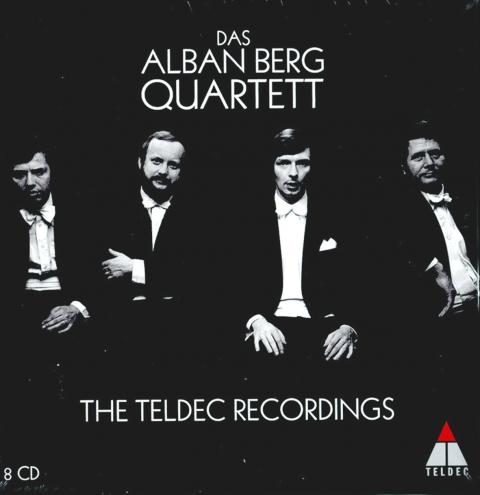Mozart’s mature string quartets are among my favorite music. There are ten of them: a set of six dedicated to the composer’s friend and mentor Haydn; a final three written for the King of Prussia, who was a keen amateur cellist; and a single, seventh in the series, called the Hoffmeister. Hoffmeister was a music publisher in Vienna and it’s thought that Mozart wrote it for him in payment of a debt.
Although Mozart wrote 23 string quartets in all, these last ten are in a class of their own. He’s on record as saying that they had cost him much labor, and we also know of an evening when Haydn, Mozart’s father Leopold and Mozart himself (on viola) played some of them through, Haydn telling Leopold afterwards that his son was one of the greatest musical geniuses, living or dead.
What, then, are the recordings to be recommended? Most are on CD, and many at bargain prices where the recordings are none too new. This doesn’t matter as it’s a relatively easy matter to record just four instruments at very high quality.

Also, many quartets issue sets, either of the six “Haydn” quartets or of all ten. These are always good value for money, and in addition I can’t imagine anyone who enjoys one of these supreme masterpieces who doesn’t want to own all of them.
I naturally haven’t heard all the sets on offer, but I do know those by the Hagen Quartet, the Chilingirian Quartet, the Alban Berg Quartet, the Talich Quartet and the (French) Quatuor Ysaye.
There has been some controversy over the Alban Berg Quartet’s Mozart CDs, with the hostile critics claiming that the lineup became too loud and full of itself, and that their early recordings on the Teldec label were greatly preferable. Luckily, a boxed set of these early recordings, made between 1971 and 1979, is available at a bargain price and includes all ten of Mozart’s mature works in the medium.

The Hagen Quartet is always a front-runner in any discussion of the quartet repertoire. With Mozart, they offer all 23 works, plus the Eine Kleine Nachtmusik arranged for quartet. If you find these as single CDs it’s possible to buy the ten mature works on four CDs, beginning with K.387 on CD 4.
Mozart’s works are all followed by a number preceded by the letter “K.” This is because one Ludwig Ritter von Kochel published a complete Mozart catalogue, after which works were identified by their Kochel number. The ten mature quartets begin with K.387 and end with K.590.
The Ysaye Quartet, recording just the six “Haydn” quartets in the version I heard, were too forceful for me. I like chamber music to be either grand or intimate, and the Ysaye versions are not quite either.

The Talich Quartet, however, are excellent, and they too issue all 23 quartets on seven CDs. Various other compilations are on offer from Talich, such as the Dissonance quartet paired with the Clarinet Quintet on the Calliope label. Dissonance is one of the quartets dedicated to Haydn, and it acquired this name on account of the slow introduction to the first movement which was thought to explore unusual harmonies for its era.
Finally, the Chilingirian Quartet. Their versions have almost everything. They’re both sensuous and disciplined, finely played and full of feeling. And so I’m going to rate them as first choice, with the versions by the Hagen Quartet a fairly close second — but with one crucial reservation.
This is that nothing can compare with the old recordings of the celebrated Budapest Quartet. They have the supreme quality of emphasizing the darker side of Mozart, in my view the ultimate Holy Grail. No set of all ten quartets from the Budapest Quartet, it seems, exists, but performances of the six “Haydn” quartets have been collected into one box, and this must stand as the Ultimate First Choice, incomplete though it is. It’s most easily bought from www.prestoclassical.co.uk.

Meanwhile, the Dissonance can be heard played complete, in 1953, by the Budapest Quartet – sound only — on YouTube (uploaded by viool7). This — so grand, so sad — is a pinnacle in the field of any Mozart quartet listening experience.
Watching the players is more difficult, though the Hagen have issued DVDs of all ten quartets, and the Gewanthaus Quartet of three of them. So, what else is available on YouTube? For some reason, the
Dissonance features prominently. You can see it played by the young Stradivari Quartet in London’s Wigmore Hall in 2011, by the New Russian Quartet, and by the St. Petersburg Quartet, as well as by the Gewanthaus and the Hagens. Take a look and make your choice. But whatever you do, don’t fail to listen to the incomparable Budapest item.

MOZART: “HAYDN” QUARTETS
Mozart
Budapest Quartet
Magdalen METCD8011 [2 CDs]
THE GREAT STRING QUARTETS
Mozart
Chilingirian Quartet
CRD 5005 [5 CDs]
THE STRING QUARTETS
Mozart
Hagen Quartet
DG Collectors Edition 4776253 [7 CDs]
ALBAN BERG TELDEC RECORDINGS
Mozart and others
Alban Berg Quartet
Teldec 2564696067 [8 CDs]
MOZART STRING QUARTETS
Mozart
Talich Quartet
La Dolce Vita LDV 1006 [7 CDs]

Desperate dads meet in car parks to exchange packets; exhausted parents slip it into their kids’ drinks; families wait months for prescriptions buy it “off label.” But is it worth the risk? “The first time I gave him a gummy, I thought, ‘Oh my God, have I killed him?’ He just passed out in front of the TV. That never happens.” Jen remembers giving her son, David, six, melatonin to help him sleep. She got them from a friend, a pediatrician who gave them to her own child. “It was sort of hilarious. She had half a tub of gummies,

June 23 to June 29 After capturing the walled city of Hsinchu on June 22, 1895, the Japanese hoped to quickly push south and seize control of Taiwan’s entire west coast — but their advance was stalled for more than a month. Not only did local Hakka fighters continue to cause them headaches, resistance forces even attempted to retake the city three times. “We had planned to occupy Anping (Tainan) and Takao (Kaohsiung) as soon as possible, but ever since we took Hsinchu, nearby bandits proclaiming to be ‘righteous people’ (義民) have been destroying train tracks and electrical cables, and gathering in villages

The wide-screen spectacle of Formula One gets a gleaming, rip-roaring workout in Joseph Kosinski’s F1, a fine-tuned machine of a movie that, in its most riveting racing scenes, approaches a kind of high-speed splendor. Kosinski, who last endeavored to put moviegoers in the seat of a fighter jet in Top Gun: Maverick, has moved to the open cockpits of Formula One with much the same affection, if not outright need, for speed. A lot of the same team is back. Jerry Bruckheimer produces. Ehren Kruger, a co-writer on Maverick, takes sole credit here. Hans Zimmer, a co-composer previously, supplies the thumping

Swooping low over the banks of a Nile River tributary, an aid flight run by retired American military officers released a stream of food-stuffed sacks over a town emptied by fighting in South Sudan, a country wracked by conflict. Last week’s air drop was the latest in a controversial development — private contracting firms led by former US intelligence officers and military veterans delivering aid to some of the world’s deadliest conflict zones, in operations organized with governments that are combatants in the conflicts. The moves are roiling the global aid community, which warns of a more militarized, politicized and profit-seeking trend